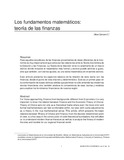Mostrar el registro sencillo del ítem
Los fundamentos matemáticos: teoría de las finanzas
| dc.creator | Cárcamo C, Ulises | spa |
| dc.date.accessioned | 2016-01-29T23:02:41Z | |
| dc.date.available | 2016-01-29T23:02:41Z | |
| dc.date.created | 2003-12-31 | |
| dc.identifier.issn | 0120-6346 | |
| dc.identifier.uri | http://revistas.udem.edu.co/index.php/economico/article/view/1365 | |
| dc.identifier.uri | http://hdl.handle.net/11407/1946 | |
| dc.description | Para aquellos estudiosos de las finanzas provenientes de áreas diferentes de la Economía es muy importante el que conozcan las relaciones entre la Teoría Económica de la Elección y las Finanzas. La Teoría de la Elección sirve no solamente de un marco teórico donde inclusive el matemático más formal y estricto puede sentirse a gusto, sino que también, con ciertos ajustes, es una teoría matemática en el sentido estricto.Este artículo presenta los aspectos básicos de la relación de esta teoría con las finanzas, desde el punto de vista discreto y determinístico. Éste es un primer paso en la conformación de bases teóricas sólidas que permitan no sólo entender las modernas teorías financieras sino también analizar la conveniencia de esas teorías y modelos para explicar los fenómenos financieros de nuestra región. | spa |
| dc.description.abstract | For those approaching Finance from backgrounds different from Economics it is very important to know the relation between Finance and the Economic Theory of Choice. Theory of Choice acts not only as a theoretical frame where even the more strict and formal mathematicians can feel comfortable within, but also (with some adjustments) as a theory in the true mathematical sense. This article, which presents the basic relations between Theory of Choice and Finance, from the discrete-deterministic point of view, is a first step in the construction of solid theoretical foundations that will allow us to understand modern finance literature as well as to analyze the fitness of modern theories and models for our regional financial world. | eng |
| dc.format.extent | p.109-132 | spa |
| dc.format.medium | Electrónico | spa |
| dc.format.mimetype | application/pdf | |
| dc.format.mimetype | text/html | |
| dc.format.mimetype | ||
| dc.language.iso | spa | |
| dc.publisher | Universidad de Medellín | spa |
| dc.relation | http://revistas.udem.edu.co/index.php/economico/article/view/1365/1392 | spa |
| dc.relation | http://revistas.udem.edu.co/index.php/economico/article/view/1365/1402 | spa |
| dc.relation.ispartofseries | Semestre Económico; Vol. 6, núm. 12 (2003) | spa |
| dc.relation.haspart | Semestre Económico; Vol. 6, núm. 12 - julio/diciembre 2003 | spa |
| dc.rights.uri | http://creativecommons.org/licenses/by-nc-sa/4.0/ | * |
| dc.source | Semestre Económico; Vol. 6, núm. 12 (2003) | spa |
| dc.source | 2248-4345 | spa |
| dc.source | 0120-6346 | spa |
| dc.title | Los fundamentos matemáticos: teoría de las finanzas | spa |
| dc.relation.citationvolume | 6 | |
| dc.relation.citationissue | 12 | |
| dc.relation.citationstartpage | 109 | |
| dc.relation.citationendpage | 132 | |
| dc.audience | Comunidad Universidad de Medellín | spa |
| dc.publisher.faculty | Facultad de Ciencias Económicas y Administrativas | spa |
| dc.coverage | Lat: 06 15 00 N degrees minutes Lat: 6.2500 decimal degreesLong: 075 36 00 W degrees minutes Long: -75.6000 decimal degrees | spa |
| dc.publisher.place | Medellín | spa |
| dc.relation.ispartofes | Semestre Económico | spa |
| dc.identifier.eissn | 2248-4345 | |
| dc.type.version | info:eu-repo/semantics/publishedVersion | |
| dc.type.driver | info:eu-repo/semantics/article |



